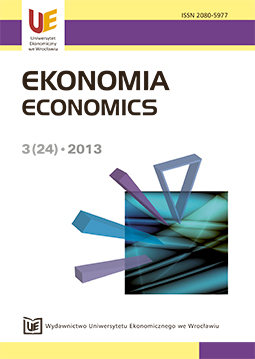Rozwój sektora finansowego a wzrost gospodarczy na przykładzie Indii
Financial system development and economic growth – case study of India
Author(s): Marta Ostrowska, Marika Lach, Karolina WójcickaSubject(s): Economy
Published by: Wydawnictwo Uniwersytetu Ekonomicznego we Wrocławiu
Keywords: India; financial system; economic growth; microfinance; capital market
Summary/Abstract: The aim of the article is to analyze the relationship between financial system development and economic growth. The influence of financial system development on real economy has been an object of interest of economists for a long time, which is confirmed by numerous empirical studies. A vast majority of scientists believes that there is a strong positive correlation between the level of financial development (financial system development in particular) and economic growth. Many empirical studies confirm that countries with a well developed financial system manage to achieve improvement in various social development indicators at the same time. The analysis presented in the article is based on the case study of India, an emerging market, where a number of financial reforms took place. The reforms enabled development of both the Indian banking sector and capital market. In the last couple of years India joined the group of countries with huge development potential. Due to steady economic growth, India has entered the top 10 of the world biggest economies. Financial system reforms contributed to the increase in the number of banks. New private banks were established and foreign banks entered the market. Unfortunately, it has proved not to be sufficient to grant an entire financial inclusion. In spite of the fact that financial assets in India are dominated by banking assets, the further development of banking sector is impeded by high agency costs and obstacles to market penetration. Even though the banking sector in India is relatively big, only 55 percent of population owns bank accounts and merely 5.9 percent − credit cards. In economic literature it is commonly accepted that microfinance creates an opportunity for the poor to access banking products and services, which should consequently lead to further economic growth. Capital market deregulation and liberalization attracted professional intermediaries and resulted in an increase in listed companies. During the upswing on global financial markets, the market capitalization to GDP ratio in India was higher than the ratio in developed economies. However, dynamic growth of market valuations of listed companies is not matched by the trading volume, which is proved by relatively low values of turnover ratio and stocks traded-to-GDP ratio. In a short period of time India managed to create a well-developed derivatives market from scratch. However, fixed income market in India is dominated by Treasury securities with corporate debt constituting only a small and illiquid segment of the market. Developed equity market and new lending growth constitute an important source of capital necessary for further development of domestic companies.
Journal: Ekonomia
- Issue Year: 2013
- Issue No: 24
- Page Range: 44-62
- Page Count: 19
- Language: Polish

